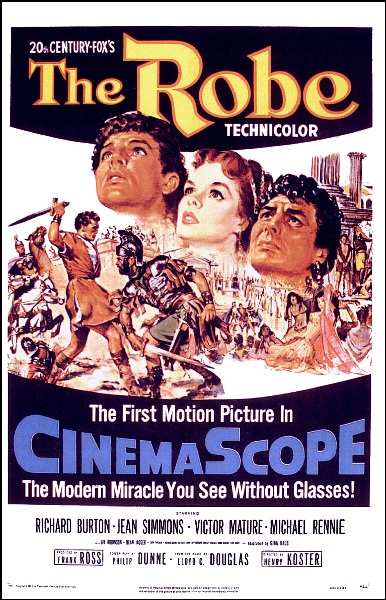Looking over the list of the top ticket-selling films of all time, I counted that within the Top 50 I had seen all but 5 films. So now I'm going to watch them. This is # 1 of 5. Ticket Sales: 65,454,500 It ranks #44 on the list just ahead of Pirates Of The Caribbean: Dead Man's Chest and just behind American Graffiti.
This is a sword and sandals epic, with thousands of extras in colorful costumes, magnificent matte paintings for the backgrounds, immense sets with intricate columns and statuary, and a few cameos from familiar biblical figures playing out well known events just beyond the scope of our characters. This film is part of the genre of Christ stories without Christ, like #13 on the list Ben-Hur or that other one. The plot concerns a Greek slave and his Roman master who acquire the haunted death robe of Jesus Christ. Someone even says of Jesus "Evil never dies." Alright, I'm interested.
Richard Burton, in his least favorite role apparently, is Marcellus, a Roman Tribune widely known as a drunk and a womanizer. After infuriating the future Emperor Caligula (nice foresight) he gets the same treatment as Anthony Edwards in the movie Downtown: he gets transferred to the worst precinct. In this case, he has to leave cosmopolitan Rome for the faraway corner of the Empire known as Jerusalem. He brings his new slave Demetrius, played by Victor Mature, and whilst Marcellus is content to live out his life more or less the same as before, Demetrius gets caught up in the wake of this rabble-rousing preacher named Jesus.
Now ol' Christ never really appears on screen; he kinda gets the Muhammad treatment here. Other people look off-screen at him, and sometimes you see his body, but never his head or hair or face, and you only get to hear him say one of his classic one liners. He's only around long enough to get crucified so our heroes can win his pre-death robe in a game of dice. It's got some magic powers, like causing rainstorms or hurting jerks if they wear it during said rainstorms or causing the downfall of the Roman Empire. Its a pretty nifty robe.
Michael Ansara has an overwrought cameo as Judas, with thunder clapping furiously and ominously once he introduces himself. Ansara played Commander Kang on the original Star Trek and then again on the later shows, but I always recognize his voice as Mr. Freeze from Batman: The Animated Series. Pontius Pilate, Peter, Miriam, and other ancillary characters of the bible show up for brief scenes. Its fun to see Christianity portrayed as 'the lil' cult that could', when it was still in its infancy and the Emperor though he could still order its suppression and eradication. Most of the Romans still refer to Jesus as 'the magician' which gives you an idea of how seriously they took them as a threat.
I'm not quite sure how this movie sold so many tickets. There's nothing wrong with it. I enjoyed it. But I can't see why more people didn't want to see Spartacus, or The Fall Of The Roman Empire, or even Sinbad The Sailor. I think it has something to do with the scope. Right from the begging, director Henry Koster lets you know that this is a BIG film. Dramatic choir music builds as curtains rise when the picture begins and the bigness doesn't stop there. It didn't even start there; it started behind the camera. This was the first widescreen release, courtesy of CinemaScope; as you can see from the poster, this was marketed as superior to 3D. I wonder if this current crop of 3D films will lead to even wider 2D films. I wanna see how wide they can possibly get! That's what she said. Always classy to end a bible picture review with a vagina joke.


No comments:
Post a Comment